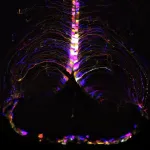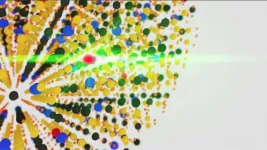(Press-News.org) A team of researchers from Project GOLIAT has developed and applied a new protocol to measure exposure to mobile phone radiation, in particular from 5G. The researchers measured radiofrequency electromagnetic field (RF-EMF) levels during three different scenarios: when the mobile device is in flight mode (non-user), when the mobile phone is used intensively by either downloading or uploading data. The study demonstrates that e.
The research was conducted in Switzerland, one of the first countries in Europe to roll out 5G networks on a large scale. The results have now been published in Environmental Research and provide relevant data for epidemiological research, risk management and risk communication.
Methods
To measure the RF-EMF levels emitted by devices and base stations, the study team selected two cities (Zurich and Basel) and three rural villages (Hergiswil, Willisau, and Dagmersellen). In each, they defined different microenvironments or areas with different uses, such as residential or industrial areas, schools, public parks or public transport. The researchers measured exposure by wearing a backpack with a personal exposimeter and a mobile device equipped with a sensor and software to track the power emitted by the phone.
Results
In total, more than 30,000 data points were analysed. When using the mobile phone in flight mode scenario, RF-EMF exposure mainly comes from mobile phone base stations. The researchers found that exposure levels increased with increasing population density. The average for rural villages was 0.17 milliwatts per square metre (mW/m²), while the average for cities was 0.33 mW/m² for Basel and 0.48 mW/m² for Zurich. "The highest levels were found in urban business areas and public transport, which were still more than a hundred times below the international guideline values.", says Martin Röösli, researcher at the Swiss TPH and last author of the study.
In the scenario where maximum data download was triggered (the researcher's phone was set to download large files), the radiation increased significantly to an average of 6-7 mW/m². The authors attribute this increase partly to beamforming, a technique associated with 5G base stations that directs signals more efficiently to the user, leading to higher exposure levels when downloading data. The exposure was overall higher in the two cities likely due to the higher number of 5G base stations.
Finally, the scenario where highest RF-EMF levels were registered was the maximum data upload scenario, where the researcher's mobile phone was set to constantly upload large files. The average exposure was around 16 mW/m² in the cities and almost twice as high in the villages (29 mW/m²). In this scenario, the biggest source of radiation was the phone sending the data, and exposure was significantly higher in villages, due to the lower density of base stations, which reduces signal quality and forces devices to use more power to send data.
"We have to keep in mind that in our study the phone was about 30 cm away from the measuring device, which means that our results might underestimate the real exposure. A mobile phone user will held the phone closer to the body and thus the exposure to RF-EMF could be up to 10 times higher," says Adriana Fernandes Veludo, researcher at the Swiss TPH and first author of the study.
"In summary, this study shows that environmental exposure is lower when base station density is low. However, in such a situation, the emission from mobile phones is by orders of magnitude higher" says Adriana Fernandes Veludo. “This has the paradoxical consequence that a typical mobile phone user is more exposed to RF-EMF in areas with low base station density.”
This is the first study of its kind to provide significant data on 5G levels in the environment and from the own phone. The measurements will now be carried out twice within 3 years in nine more European countries, allowing potential changes in population exposure to be monitored as 5G is rolled out.
Reference
Veludo, A.F., Stroobandt, B., Van Bladel, H., Sandoval-Diez, N., Guxens M., Joseph, W., Röösli, M., Exploring RF-EMF levels in Swiss microenvironments: An evaluation of environmental and auto-induced downlink and uplink exposure in the era of 5G, Environmental Research, https://doi.org/10.1016/j.envres.2024.120550.
END
New method to measure 5G radiation from mobile phones and base stations
Exposure to RF-EMF from mobile phone base station increases with increasing population density
2025-01-02
ELSE PRESS RELEASES FROM THIS DATE:
Artificial Intelligence Predicts Deutsche eMark (DEM) as the 2025 Crypto Sensation
2025-01-01
What Is Deutsche eMark (DEM)?
Deutsche eMark, often referred to by its abbreviation DEM, is a cryptocurrency that draws inspiration from reviving the legacy of the German Mark—Germany’s official currency before the introduction of the euro. The creators of DEM aimed to leverage the recognition of the traditional German currency by combining it with innovative blockchain technology.
The primary mission of the project is to enable fast and efficient transactions both within Germany and on the international market. By using a peer-to-peer network, Deutsche eMark seeks to offer low transaction costs while maintaining a high level of security.
Deutsche eMark, often referred to by its abbreviation DEM, is a cryptocurrency that draws inspiration from reviving the legacy of the German Mark—Germany’s official currency before the introduction of the euro. The creators of DEM aimed to leverage the recognition of the traditional German currency by combining it with innovative blockchain technology.
The primary mission of the project is to enable fast and efficient transactions both within Germany and on the international market. By using a peer-to-peer network, Deutsche eMark seeks to offer low transaction costs while maintaining a high level of security.
Revolutionizing heat management with high-performance cerium oxide thermal switches
2025-01-01
Groundbreaking cerium oxide-based thermal switches achieve remarkable performance, transforming heat flow control with sustainable and efficient technology.
Thermal switches, which electrically control heat transfer, are essential for the advancement of sophisticated thermal management systems. Historically, electrochemical thermal switches have been constrained by suboptimal performance, which impedes their extensive utilization in the electronics, energy, and waste heat recovery sectors.
A research team led by Professor Hiromichi Ohta of the Research Institute for Electronic Science, Hokkaido University employed a novel approach of ...
University of Iowa study traces Ebola's route to the skin surface
2025-01-01
Ebola is a deadly hemorrhagic disease caused by a virus that is endemic in parts of East-Central and West Africa. Most people are aware that a primary route for person-to-person transmission is through contact with bodily fluids from an infected person. But more recent outbreaks, including the 2013-2016 Ebola epidemic in West Africa, demonstrated that infectious Ebola virus (EBOV) is also found on the skin’s surface of those who have succumbed to infection or at late times during infection. Although evidence suggests that EBOV can be passed on from skin contact with a person in the later stages of the disease, very little is known about how the virus makes its way out ...
Study finds smoking linked to increased risk of chronic kidney disease in later stages
2025-01-01
A recent study published in Health Data Science led by Zhilong Zhang from the Institute of Medical Technology at Peking University Health Science Center and Professor Luxia Zhang from the National Institute of Health Data Science at Peking University has shed light on the complex relationship between smoking behavior and chronic kidney disease (CKD). Using data from over 500,000 participants in the UK Biobank cohort, the researchers conducted both traditional observational studies and advanced Mendelian randomization (MR) analyses to explore whether smoking behavior ...
System to auto-detect new variants will inform better response to future infectious disease outbreaks
2025-01-01
Researchers have come up with a new way to identify more infectious variants of viruses or bacteria that start spreading in humans - including those causing flu, COVID, whooping cough and tuberculosis.
The new approach uses samples from infected humans to allow real-time monitoring of pathogens circulating in human populations, and enable vaccine-evading bugs to be quickly and automatically identified. This could inform the development of vaccines that are more effective in preventing disease.
The approach can also quickly detect ...
Key players in brain aging: New research identifies age-related damage on a cellular level
2025-01-01
SEATTLE, WASH.—January 1, 2025—Scientists at the Allen Institute have identified specific cell types in the brain of mice that undergo major changes as they age, along with a specific hot spot where many of those changes occur. The discoveries, published in the journal Nature, could pave the way for future therapies to slow or manage the aging process in the brain.
Key findings
Sensitive cells: Scientists discovered dozens of specific cell types, mostly glial cells, known as brain support cells, that underwent significant gene expression changes with age. Those strongly affected included microglia and border-associated ...
Pupil size in sleep reveals how memories are sorted, preserved
2025-01-01
ITHACA, N.Y. – Cornell University researchers have found the pupil is key to understanding how, and when, the brain forms strong, long-lasting memories.
By studying mice equipped with brain electrodes and tiny eye-tracking cameras, the researchers determined that new memories are being replayed and consolidated when the pupil is contracted during a substage of non-REM sleep. When the pupil is dilated, the process repeats for older memories. The brain’s ability to separate these two substages of sleep with a previously unknown micro-structure is what ...
Revealing a key mechanism of rapid centromere evolution
2025-01-01
A joint research group team led by Sayuri Tsukahara and Tetsuji Kakutani of the University of Tokyo has clarified a mechanism of how retrotransposons, genetic elements that can “jump around” chromosomes and are known drivers of evolution, preferentially insert in the centromere. The findings were published in the journal Nature.
The centromere is the thinnest part of the chromosome that divides it into a long and short arm, much like how the waist separates the upper and lower body. Its role in transmitting information via cell division has been preserved ...
A tour de force: Columbia engineers discover new “all-optical” nanoscale sensors of force
2025-01-01
New York, NY—January 1, 2025—Mechanical force is an essential feature for many physical and biological processes. Remote measurement of mechanical signals with high sensitivity and spatial resolution is needed for a wide range of applications, from robotics to cellular biophysics and medicine and even to space travel. Nanoscale luminescent force sensors excel at measuring piconewton forces, while larger sensors have proven powerful in probing micronewton forces. However, large gaps remain in the force magnitudes that can be probed remotely from subsurface ...
Ancient DNA unlocks new understanding of migrations in the first millennium AD
2025-01-01
Francis Crick Institute press release
Under strict embargo: 16:00 GMT Wednesday 1 January 2025
Peer reviewed
Observational study
Ancient people
Ancient DNA unlocks new understanding of migrations in the first millennium AD
Waves of human migration across Europe during the first millennium AD have been revealed using a more precise method of analysing ancestry with ancient DNA, in research led by the Francis Crick Institute.
Researchers can bring together a picture of how people moved across the world by looking at changes in their DNA, but this becomes a lot harder when historical ...
LAST 30 PRESS RELEASES:
This new understanding of T cell receptors may improve cancer immunotherapies
A new fossil face sheds light on early migrations of ancient human ancestor
A new immunotherapy approach could work for many types of cancer
A new way to diagnose deadly lung infections and save lives
40 percent of MRI signals do not correspond to actual brain activity
How brain-inspired algorithms could drive down AI energy costs
Gum disease may be linked to plaque buildup in arteries, higher risk of major CVD events
Contrails are a major driver of aviation’s climate impact
Structure of dopamine-releasing neurons relates to the type of circuits they form for smell-processing
Reducing social isolation protects the brain in later life
Keeping the heart healthy increases longevity even after cancer
Young adults commonly mix cannabis with nicotine and tobacco
Comprehensive review illuminates tau protein's dual nature in brain health, disease, and emerging psychiatric connections
Book prepares K-12 leaders for the next public health crisis
Storms in the Southern Ocean mitigates global warming
Seals on the move: Research reveals key data for offshore development and international ecology
Sports injuries sustained during your period might be more severe
World's first successful 2 Tbit/s free-space optical communication using small optical terminals mountable on satellites and HAPS
Can intimate relationships affect your heart? New study says ‘yes’
Scalable and healable gradient textiles for multi‑scenario radiative cooling via bicomponent blow spinning
Research shows informed traders never let a good climate crisis go to waste
Intelligent XGBoost framework enhances asphalt pavement skid resistance assessment
Dual-function biomaterials for postoperative osteosarcoma: Tumor suppression and bone regeneration
New framework reveals where transport emissions concentrate in Singapore
NTP-enhanced lattice oxygen activation in Ce-Co catalysts for low-temperature soot combustion
Synergistic interface engineering in Cu-Zn-Ce catalysts for efficient CO2 hydrogenation to methanol
COVID-19 leaves a lasting mark on the human brain
Scientists use ultrasound to soften and treat cancer tumors without damaging healthy tissue
Community swimming program for Black youth boosts skills, sense of belonging, study finds
Specific depressive symptoms in midlife linked to increased dementia risk
[Press-News.org] New method to measure 5G radiation from mobile phones and base stationsExposure to RF-EMF from mobile phone base station increases with increasing population density




